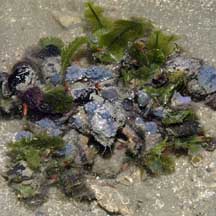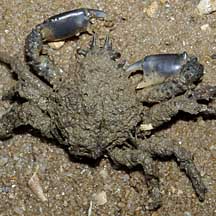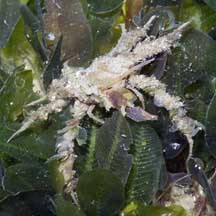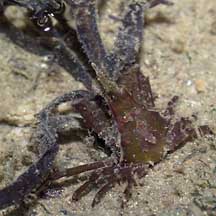Spider
crabs
Superfamily Majoidea
updated
Dec 2019
if you
learn only 3 things about them ...
 They
are often very well camouflaged. Look out for unusual
movement. They
are often very well camouflaged. Look out for unusual
movement.
 Some are tiny and look like bits of dirt. Some are tiny and look like bits of dirt.
 They have pointed heads and long skinny legs. They have pointed heads and long skinny legs. |
|
Where
seen? Spider crabs are encountered on all our shores. But
they're hard to spot. In addition to being slow-moving and well camouflaged,
many are also small.
Features: Body width 0.5-3cm.
These crabs are well disguised. They have long, skinny legs that give
them their common name. Some have legs and bodies that resemble roots
or other bits of debris so they blend perfectly with their surroundings.
Body usually triangular, tapering to a point at the head with the
small eyes on the sides of the tip. The body is often covered with
spines, knobs and hooked hairs. Some decorate themselves with living
seaweeds, sponge, other animals or bits of coral and rubbish.They
are also slow-moving, so it's hard to penetrate their disguise. |
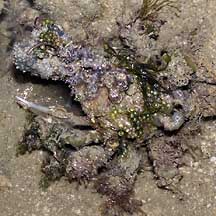
Decorated upperside |
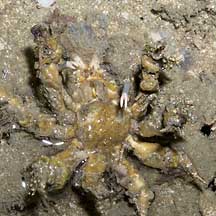
Underside, only the pincers are 'undecorated'.
Chek Jawa, Aug 05 |
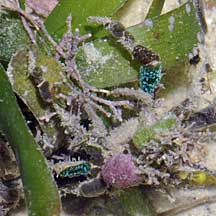
Almost impossible to spot until it moves.
Cyrene Reef, Jul 10 |
Special Spider: Our tiny spider
crabs are cousins of the biggest crab in the world! The Japanese spider
crab (Macrocheira kaempferi), with a leg span of 4m, belongs
to the same family.
Human uses: Unfortunately,
the Velcro crab (Camposcia retusa)
is among those sold in the live aquarium trade. Some large spider crabs in temperate seas are important commercially
as seafood. They are harvested by the ton. These include the Canadian
snow crab (Chionoecetes opilio) which can have a body width
of about 16cm, leg span of 90cm, and weigh more than 1kg; and the
European spiny spider crab (Maja squinado) which can have a
body width of 8.5-20cm and pincers up to 1m long!
Status and threats: One of our spider crabs are listed
among the threatened animals in Singapore. However, like other creatures of the intertidal zone, they are affected
by human activities such as reclamation and pollution. Trampling by
careless visitors and over-collection can also have an impact on local
populations. |
| Some Spider
crabs on Singapore shores |
Superfamily
Majoidea recorded for Singapore
from Wee Y.C. and Peter K. L. Ng. 1994.
A First Look at Biodiversity in Singapore
*from Tan, Leo W. H. & Ng, Peter K. L., 1988. A Guide to Seashore
Life.
**from Lim, S., P. Ng, L. Tan, & W. Y. Chin, 1994. Rhythm of the
Sea: The Life and Times of Labrador Beach.
***Ng, Peter K. L. and Daniele Guinot and Peter J. F. Davie, 2008.
Systema Brachyurorum: Part 1. An annotated checklist of extant Brachyuran
crabs of the world.
in red are those listed among the threatened
animals of Singapore from Davison, G.W. H. and P. K. L. Ng
and Ho Hua Chew, 2008. The Singapore Red Data Book: Threatened
plants and animals of Singapore.
| |
Spider
crabs seen awaiting identification
Species are difficult to positively identify without
close examination.
On this website, they are grouped by external features for convenience
of display. |
| |
Micippa excavata
**Micippa philyra
*Planotergum mirabile (EN:
Endangered)
Schizophrys sp. (Sea
toad spider crab)
Schizophrys aspera
Schizophrys dama |
| |
***Family
Epialtidae (previously Majidae) |
| |
Chlorinoides gemaini
*Doclea canaliformis (EN:
Endangered)
Hyastenus aries
Hyastenus diacanthus
Hyastenus elatus (EN: Endangered)
Hyastenus sebae
Hyastenus subinermis (EN: Endangered)
Menatheius sp. (Arrow-head
spider crab)
**Menaethius monoceros (One-horned
spider crab) (VU: Vulnerable)
Phalangipus arachnoides
Tylocarcinus styx
Xenocarcinus tuberculatus |
| |
***Family
Inachidae (previously
Majidae) |
| |
Camposcia
retusa (Velcro crab) (VU:
Vulnerable)
Paratymolus cygnus
(CR: Critically endangered)
Paratymolus pubescens |
|
Links
References
- Ng, Peter
K. L. and Daniele Guinot and Peter J. F. Davie, 2008. Systema
Brachyurorum: Part 1. An annotated checklist of extant Brachyuran
crabs of the world. The Raffles Bulletin of Zoology. Supplement
No. 17, 31 Jan 2008. 286 pp.
- Lim, S.,
P. Ng, L. Tan, & W. Y. Chin, 1994. Rhythm of the Sea: The Life
and Times of Labrador Beach. Division of Biology, School of
Science, Nanyang Technological University & Department of Zoology,
the National University of Singapore. 160 pp.
- Wee Y.C.
and Peter K. L. Ng. 1994. A First Look at Biodiversity in Singapore.
National Council on the Environment. 163pp.
- Davison,
G.W. H. and P. K. L. Ng and Ho Hua Chew, 2008. The Singapore
Red Data Book: Threatened plants and animals of Singapore.
Nature Society (Singapore). 285 pp.
- Jones Diana
S. and Gary J. Morgan, 2002. A Field Guide to Crustaceans of
Australian Waters. Reed New Holland. 224 pp.
- Debelius,
Helmut, 2001. Crustacea
Guide of the World: Atlantic Ocean, Indian Ocean, Pacific Ocean
IKAN-Unterwasserachiv, Frankfurt. 321 pp.
- Gosliner,
Terrence M., David W. Behrens and Gary C. Williams. 1996. Coral
Reef Animals of the Indo-Pacific: Animal life from Africa to Hawaii
exclusive of the vertebrates
Sea Challengers. 314pp.
|
|
|




